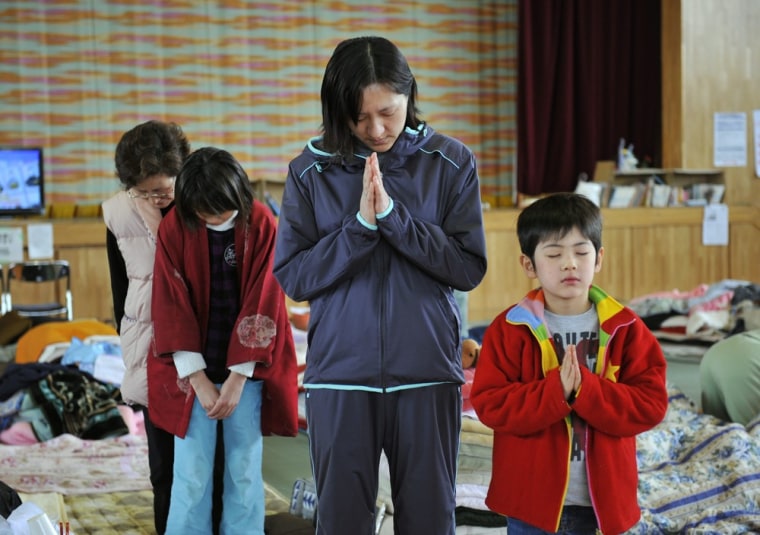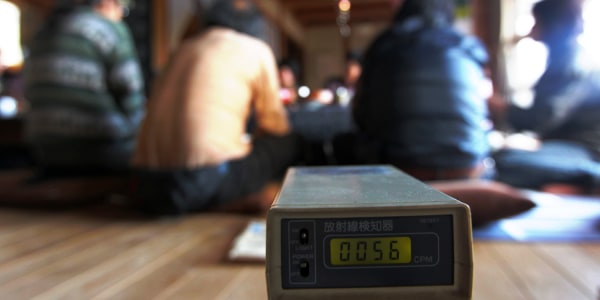Japan held somber ceremonies Monday to mark one month since a massive earthquake and tsunami devastated its northeastern coast, killing up to 25,000 people and unleashing a nuclear crisis that engineers are still struggling to contain.
With thousands of bodies yet to be found, a tsunami-flooded nuclear power plant still spewing radiation and more than 150,000 people living in shelters, there was little time for reflection on Japan's worst disaster since World War II.
"Even after a month, I still cry when I watch the news," said Marina Seito, 19, a student at a junior college who recalled being in a basement restaurant when the 9.0-magnitude earthquake hit March 11. Plates fell and parts of the ceiling crashed down around her.
At the Miyagi prefecture (state) capital building in hard-hit Sendai, which has been transformed into a bustling command center for recovery efforts, all activity stopped at 10 a.m. local time, with everyone bowing their heads for a moment of silence, including Miyagi Governor Yoshihiro Murai.
"I want everyone to join hands and overcome this crisis, moving steadily toward recovery," Murai told reporters afterward.

Other ceremonies were planned for 2:46 p.m., the exact moment of the magnitude-9.0 earthquake that spawned the giant wave.
"We offer our deepest condolences to those who lost their loved ones," Chief Cabinet Secretary Yukio Edano said Monday at a brief news conference where he pledged the government would do whatever it could to help survivors and end the nuclear crisis. "We are sorry for causing inconvenience and difficulties to those who still live in shelters."
The earthquake and tsunami flattened communities along hundreds of miles of coastline, causing what the government estimates could be as much as $310 billion in damage.
No running water, power
More than 158,000 people are still without electricity and 210,000 have no running water, although some of that is because of a 7.1-magnitude aftershock that rattled the area last week.
Adding to the misery is radiation spewing from the Fukushima Dai-ichi nuclear complex 140 miles northeast of Tokyo, which lost its cooling systems when water from tsunami washed over it.
Frustrations are running particularly high among people like Atsushi Yanai, a 55-year-old construction worker forced to live in a shelter not because his home was destroyed but because it is within the evacuation zone.
Government officials have ordered people out of the zone because of radiation concerns, and those farther from the plant may also be told to leave as the crisis drags on.
"We have no future plans. We can't even start to think about it because we don't know how long this will last or how long we will have to stay in these shelters," Yanai said. "This is what is so hard for us."
Ahead of the anniversary, nuclear safety official Hidehiko Nishiyama apologized for the worry and inconvenience caused by the radiation spilling from the plant, where cooling systems disabled by the March 11 tsunami still have not been restored and likely won't be for several months.
"We've done all we could to come this far," Nishiyama said Sunday. "Unfortunately, we still cannot give any timeline for when we can move on to the next phase, but we are hoping to achieve a sustainable cooling system, contain radiation and bring the situation under control as soon as possible."
Plant operator Tokyo Electric Power Co. reiterated Sunday that it is not considering entombing the hot reactors in concrete, as was done at Chernobyl in 1986 when a reactor fire burned out of control. Japan's nuclear crisis is the world's worst since then.
The crisis has sparked several anti-nuclear protests, but one of the largest took place Sunday in a Tokyo neighborhood where many students live. Thousands of people carrying "No nukes" signs gathered for a rally and then marched through the streets chanting and beating drums.
Elsewhere in the capital, about 140 miles southwest of Fukushima Dai-ichi, protesters demanding the closure of a different plant chanted "No more Fukushima" as they marched through government headquarters and past the Nuclear and Industrial Safety Agency.
Slideshow 9 photos
After Japan's earthquake and tsunami - week 8
Sunday also saw Japanese and U.S. troops fan out along the coast for another all-out search for bodies by land, air and sea.
Television news showed them using heavy equipment to lift a boat washed inland by the tsunami so they could search a crushed car underneath. No one was inside.
Bodies found
The Japanese military said Monday that U.S. and Japanese troops found 103 bodies during the one-day operation, more than the 70 they located during a three-day push with even more troops a week ago.
Just 13,000 deaths have been confirmed so far, and many bodies have likely washed out to sea and will never be found.
Some families who had been living in shelters were able to take a tentative step toward normalcy over the weekend, moving into boxy, gray temporary houses lined up in a junior high school parking lot in the port city of Rikuzentakata.
Each unit is just 320 square feet, but replete with modern comforts such as televisions, refrigerators, microwaves and washing machines — a welcome upgrade for the homeless, many of whom have slept on the floors of school gyms for a month.
So far there are 36 houses — just one for every 50 applicants. A lottery decided who got to move in.
"It's a mystery how we were lucky enough to be chosen. It's like a dream," said Sakai Sasaki, 80, who had been living with relatives.
The city hopes to complete 400 units in eight different locations by mid-May, although that will still cover only about one-quarter of the families in need. Other areas have similar plans, but Rikuzentakata's units are the first to be completed.
"When you think of the feelings of the evacuees, we want to build them even a day faster, or make just one unit more," said Saeki Suga, an official in charge of the housing plan for the city.
